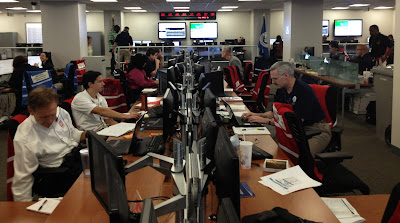 |
| The National Response Coordination Center. |
 |
| The State EOC in Tallahassee |
My case was a little different. Because of my background and the fact that I had been in my new job less that 6 months I knew more about how multi-agency coordination centers operate that I did about the Red Cross. That was okay. It was an exercise. We were all there to practice and learn.
When I was at the State EOC my view of the disaster was like flying over in a helicopter. Working in the NRCC was equivalent to viewing the Atlantic Ocean from a transcontinental flight to Europe. We took the Long View of the Big Picture.
Most of our activities revolve around responding to resource requests (provided to us by the FEMA Region) from the affected state or states and creating reports for the Big Bosses about What Is Going On. The information we collect is built into reports that inform decision makers like the FEMA Administrator and ultimately the White House.
I enjoyed working in the NRCC. Part of the reason is that the exercise had an interesting scenario. If I had spent 3 days waiting for a hurricane that fizzled my sentiments would've been different. What was really interesting was the perspective that I got from looking down on the disaster from the transcontinental airliner and how this affected my opinion about how state mass care coordinators should act when faced with large or catastrophic disasters. And that is what I want to talk about.
Most normal emergency manager people when faced with an overwhelming event naturally focus on the part of the job that is familiar to them. They see the situation getting out of control and struggle to wrest it back. They work with the resources that they have available to get the situation back under control. In most disasters this is the correct course of action.
In a large or catastrophic event the resources available are inadequate for the tasks. Getting these resources deployed is important but an even more critical task is communicating the type, kind and quantity of resource shortfalls to those outside the affected area who are able to provide those resources. If you're at the county level you need to let the state know what you need. If you're at the state you need to concentrate on getting those Resource Request Forms completed and submitted to the right FEMA person as soon as possible.
In other words, if your jurisdiction is affected then you need to direct more of your attention to those external agencies who are mobilizing to provide support. If you're not telling these external agencies what you want, when you want it and where you want it sent they aren't going to wait on you. And you may not be happy with what you end up receiving.
After requesting resources the second most important task on the state mass care coordinator's list in a catastrophic event is to help ensure all the stakeholders have a common understanding of the situation - a Common Operating Picture. The way to achieve this common understanding is to get everyone with a need to know on the same conference call every day. The state mass care coordinator is in the best situation to do this.
The purpose of the state mass care conference call is to gather and share information with all the mass care stakeholders within and outside the State EOC. Holding this conference call daily with the right agencies is critical to an effective mass care response. I cannot emphasize this point to much.
 |
| Mass Care Conference Call |
After requesting resource shortfalls and ensuring that all stakeholders have a common operating picture the third way that the state mass care coordinator can help his/her cause is by working to establish the mass care priorities for the response. The best way to do this again is through the mass care conference call. The means to this end is not by dictating priorities but by soliciting input from the key stakeholders and then working to achieve consensus. This is a tall order but the state mass care coordinator is in the best position to achieve this goal.
The sooner that the state mass care coordinator can establish a mass care conference call in order to 1) determine mass care resource shortfalls, 2) gather and distribute a common operating picture, and 3) establish mass care priorities the better the response will be. Achieving these objectives will enable those of us outside the affected area (in the NRCC, the Regional Response Coordination Center and the Red Cross Disaster Operations Coordination Center) to do a better job of suporting the survivors on the ground in the midst of the disaster.
No comments:
Post a Comment